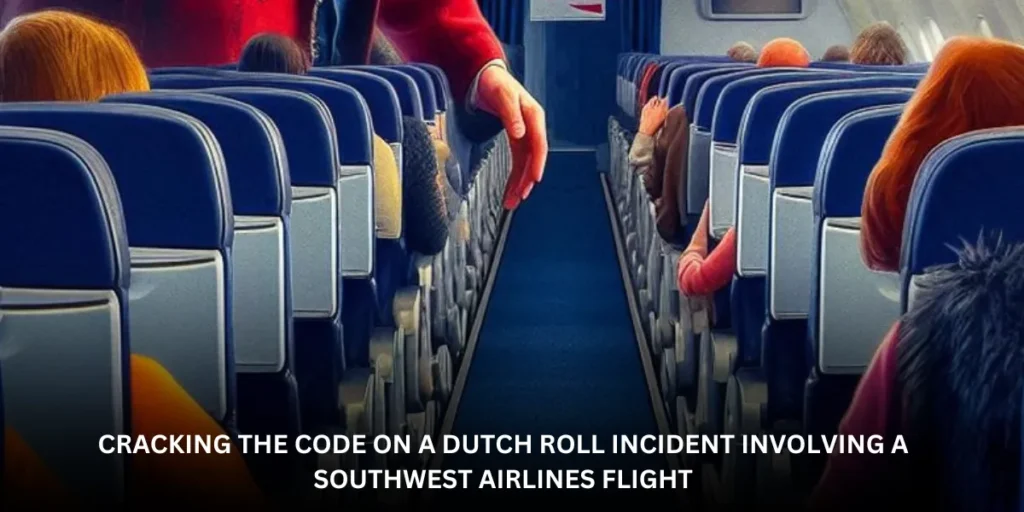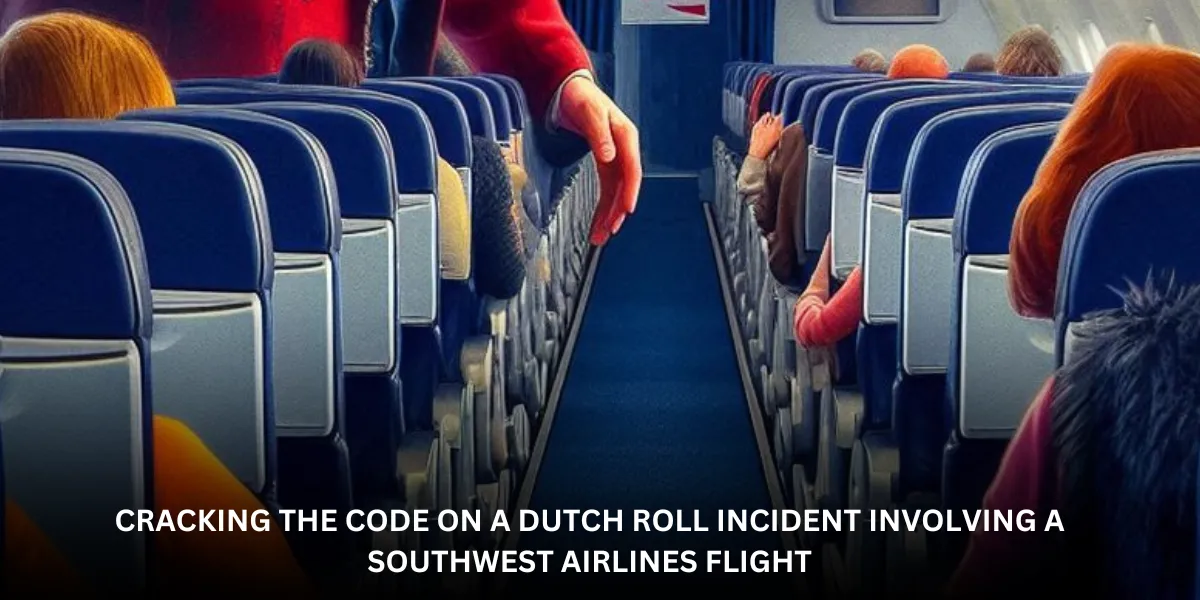Cracking the Code on a Dutch Roll Incident involving a Southwest Airlines Flight
Most of us associate beautiful sights from 30,000 feet and seamless flights with air travel. However, what occurs if there is an abrupt and unanticipated movement during flight? Today, we explore the intriguing story of a Southwest Airlines flight that experienced a “Dutch roll.” This occurrence, which happened on May 25, 2023, on a trip from Phoenix to Oakland, raised a lot of curiosity for both travelers and aviation aficionados. Let’s investigate what specifically occurred, why it occurred, and how this affects flights in the future.
Envision yourself enjoying your in-flight movies and munchies when all of a sudden the plane begins to shake up and down from side to side. This eerie sensation is called a “Dutch roll.” This was personally experienced by passengers on a Southwest Airlines flight from Phoenix to Oakland on May 25, 2023. Experts in aviation were drawn to this episode, and frequent travelers expressed worries as well. Let’s analyze what took place and why.

A Dutch roll: what is it?
An airplane that oscillates in an unsteady manner, resembling a pendulum, is said to be experiencing a Dutch roll. Although this movement might be unsettling for passengers, competent pilots are usually able to regulate it.
How Does It Take Place?
An imbalance between the aircraft’s roll (rotation along the front-to-back axis) and yaw (side-to-side movement) usually results in a Dutch roll. It frequently occurs when there is turbulence or when the plane’s automated control systems are not calibrated correctly.
The Event: What’s Clear to Us
A Dutch roll occurred on a Southwest Airlines Boeing 737 Max on May 25, 2023, as it was traveling from Phoenix to Oakland. This unexpected oscillation occurred in midair on what at first appeared to be a typical trip, creating a frightening scenario for everyone on board.
First Reports
Early accounts stated that the crew and passengers were alarmed when the plane started to vibrate suddenly. The pilots regained control and made a safe landing in Oakland despite the unsettling encounter.
Dutch Roll’s causes
To avoid such situations in the future, it is essential to comprehend why a Dutch roll happens. Numerous elements may be involved in this phenomenon:
Aerodynamic Disproportion
The airplane may oscillate due to an aerodynamic imbalance. Turbulence in the wind or problems with the aircraft’s maintenance or design could be the cause of this.
Instrument Failure
A Dutch roll can occasionally be caused by an issue with the aircraft’s instruments or automated control systems. Although the purpose of these systems is to keep the plane stable, they can malfunction and cause oscillations.
Effect on Travelers
The passengers on the Southwest Airlines flight were greatly affected by the Dutch roll event.
Effects on the Body
There may have been a severe swaying motion that caused discomfort or perhaps nausea in the passengers. These kinds of motions can be upsetting, particularly for inexperienced pilots.
Effect on Emotions
The passengers’ terror and concern were probably brought on by the abrupt and unexpected oscillation. It is terrifying to lose stability in midair, and the experience might have long-lasting psychological ramifications.
Pilot Reaction and Education
Pilots play a crucial role in handling these kinds of situations. The pilots of the Southwest Airlines flight showed extraordinary expertise in controlling the aircraft.
Pilot Education
To handle a variety of in-flight incidents, including Dutch rolls, pilots must complete extensive training. This training is essential to make sure they can respond appropriately and quickly in such circumstances.
Reaction to the Event
In order to combat the oscillations during the incident, the pilots adhered to normal protocols. They guaranteed everyone’s safety on board and helped avert more issues with their prompt and composed response.
Design and Safety of Aircraft
A key factor in preventing events such as Dutch rolls is aircraft design.
Design Elements
Sophisticated stability-maintenance systems are fitted to modern airplanes. Among these are yaw dampers, which stop oscillations by automatically correcting any yawing motion.
Safety Procedures
Several safety procedures and redundancies are included in by manufacturers to manage scenarios in which primary systems malfunction. These procedures are regularly revised in light of fresh discoveries and occurrences.
The Repercussions
Authorities in the aviation industry and Southwest Airlines moved quickly to resolve the Dutch roll event.
Passenger Assistance
provided with assistance and recompense for their hardship. For individuals who were in extreme distress, counseling services were part of this.
Inspections for maintenance
In order to find any flaws that might have contributed to the incident, the affected aircraft underwent extensive maintenance inspections. The first task was making sure the plane was airworthy.
Research and Results
To identify the primary reason of the Dutch roll on the Southwest Airlines flight, a thorough examination was started.
First Results
According to preliminary research, the Dutch roll was caused by a momentary yaw damper system breakdown combined with turbulence. Additional examination was necessary to validate these findings.
Extended-term Evaluation
Interviewing the flight crew and looking through the flight data recorder were part of the long-term examination. This all-encompassing strategy made sure that every potential factor was taken into account.
Preventive Actions
A number of preventive measures were suggested and put into action to stop such incidents in the future.
Improved Instruction
Additional training was given to pilots with a specific focus on managing Dutch roll situations. The focus of this training was on identifying warning signals early and acting quickly to address them
Upgrades to Systems
To increase the dependability of its automated control systems, Southwest Airlines started to modernize its fleet’s systems. The goal of these changes was to lessen the possibility of recurrent events
In summary
The incident involving the Dutch roll on the Southwest Airlines flight from Phoenix to Oakland served as a sobering reminder of how complicated air travel can be. Though obviously concerning, the event also demonstrated the value of pilot training and the resilience of contemporary aircraft equipment. The aviation sector keeps improving passenger safety by figuring out what went wrong and taking preventative action.
FAQs
1. In aircraft, what is a Dutch roll?
A Dutch roll is an oscillating motion caused by an imbalance between yaw and roll that causes an aircraft to waggle up and down as well as side to side.
2. On the Southwest Airlines flight, how did the crew manage to control the Dutch roll?
In order to recover control of the aircraft and guarantee a safe landing, the pilots made use of their training and normal emergency procedures.
3. Why does a Dutch roll occur?
Turbulence, instrument problems, and aerodynamic asymmetries can all result in a Dutch roll. It frequently has to do with problems with the automated control systems of the aircraft.
4. Did the Dutch roll incident involving Southwest Airlines result in any injuries being reported?
Although there were no reports of any major injuries, the oscillation caused a great deal of discomfort and anxiety for the passengers.
5. What actions are being done to stop Dutch roll accidents in the future?
Enhancing pilot training, updating systems, and performing extensive maintenance inspections to guarantee the dependability of aviation control systems are examples of preventive actions

